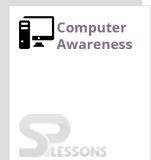 Introduction
Introduction
What is Computer Aptitude?
Computer Aptitude Test is a scientifically validated test designed to measure the aptitude for working with computers. Basically, it measures the ability to solve problems quickly that is essential to truly succeed in every field using computers.
Computers are an integral part of everyday life. Computer aptitude is an important section in many competitive exams primarily related to recruitment. Candidates preparing for banking exams like IBPS PO, SBI PO, and the RBI, must be prepared with Computer Aptitude syllabus.
"A Computer is a device that can be instructed to carry out sequences of arithmetic or logical operations automatically via computer programming". Computers follow a generalized set of operations termed as programs. The programs enable computers to perform an extremely wide range of tasks. Computers are now ubiquitous and are being used in every field of work. Thus, basic knowledge of computers and the ability to operate a computer is now crucial for all job aspirants.
Computer Awareness, also known as Computer Aptitude is one of the prominent sections in various recruitment related competitive exams in India. SBI Clerk Mains Computer Aptitude Practice Set 5 lists some of the important questions for the preparation of Computer Awareness module. The most significant topics to be learnt for Computer Awareness module are as follows:
- History of Computers
- Computer Fundamentals
- Parts of a Computer System
- Data Processing Cycle of a Computer
- Computer Languages
- Input Devices & Output Devices
- Operating Systems
- Database Management Systems
- Microsoft Office
- Keyboard Shortcuts
- File Extensions
- Networking and Internet
- Computer Viruses
- Important Abbreviations
 Quiz
Quiz
Directions(1-5): Computer Fundamentals Questions
1. The first mechanical calculating machine was made by
- A. William Oughtred
B. Gottfried Leibnitz
C. Blaise Pascal
D. Charles Babbage
- A. ALGOL
B. APL
C. LOGO
D. FORTH
- A. Relation
B. Schema
C. Resilience
D. Versatility
- A. Static RAM
B. Dynamic RAM
C. EPROM
D. ROM
- A. 1971-1982
B. 1982-1994
C. 1959-1964
D. 1965-1971
Directions(1-5): Parts of a Computer System Questions
1. Exceptions to the 8085 microprocessor normal operation are called:
- A. jump instructions
B. decoding
C. interrupts
D. jump instructions or interrupts
- A. 7
B. 8
C. 9
D. 16
- A. microcontroller
B. arithmetic-logic unit (ALU)
C. temporary register
D. accumulator
- A. 2
B. 3
C. 5
D. 8
- A. data bus
B. timer bus
C. control bus
D. address bus
Directions(1-2): Data Processing Questions
1. Process of arranging data into a new order is called
- A. manipulation
B. standardization
C. documentation
D. analyzation
- A. calculation
B. analysis
C. manipulation
D. all of above
- A. [latex]{1}^{st}[/latex] generation
B. [latex]{2}^{nd}[/latex] dgeneration or [latex]{3}^{rd}[/latex] generation
C. [latex]{4}^{tht}[/latex] generation
D. [latex]{5}^{th}[/latex] generation
- A. PRINT statement
B. REMARK statement
C. INPUT statement
D. DATA statement
- A. core dump
B. trace routine
C. detail listing
D. source listing
Other Articles
 Study Guide
Study Guide
| Competitive Exams - Study Guide | ||
|---|---|---|
| Category | ||
| Quantitative Aptitude | Reasoning Ability | General Awareness |
| Computer Awareness | English Knowledge | Banking Awareness |
| General Science | World of Words | Descriptive Test |
 Exams
Exams
| Competitive Exams - College Entrance Exams | |||
|---|---|---|---|
| Category | Notification | ||
| Diploma | NITC New Delhi | ||
| Click Here For – All India Entrance Exam Notifications | |||
 Daily CA
Daily CA
 Job-Alerts
Job-Alerts
 SP Quiz
SP Quiz
| Competitive Exams - Practice Sets | |
|---|---|
| Category | Quiz |
| Quant Aptitude | Permutation and Combination |
| Spotting Errors | |
| Reasoning Ability | Puzzles |
| Insurance Awareness | Insurance Awareness |
 GK
GK
| General Knowledge for Competitive Examinations | |
|---|---|
| Topic | Name of the Article |
| GK - World | Different Countries Republic Days |
| Largest Hindu Temples | |
| GK - India | Revolutions in India |
| First Indians | |
| GK - Abbreviations | Science Information Technology Abbreviations |
| Education Abbreviations | |
| GK - Banking & Insurance | Europe Countries Capitals Currencies |
| South America Countries Capitals Currencies | |
| GK - Science & Technology | Famous Websites |
| Web Portals | |



